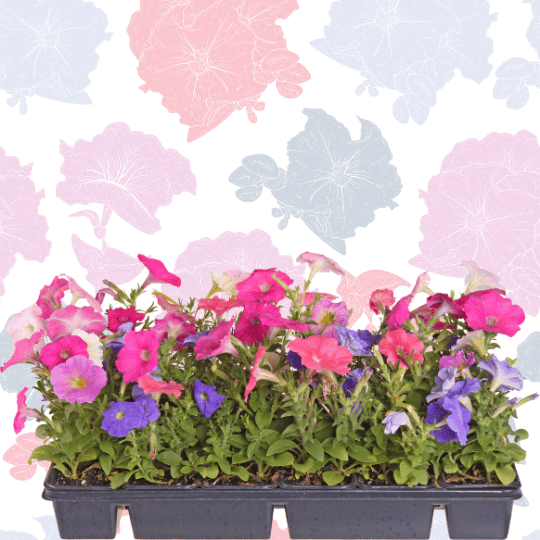Petunia Flower plants captivate with their profusion of vibrant flowers, earning them a cherished place among gardeners and flower enthusiasts alike. In this all-encompassing guide, we embark on a journey through the realm of petunias, exploring their diverse varieties, care essentials, and the myriad benefits they bestow upon your garden. Whether you’re new to gardening or a seasoned pro, this article equips you with indispensable knowledge and expert tips for cultivating and fostering thriving petunia plants.
🌸 What is Petunia?
Petunia is a stunning flowering plant known for its vibrant blossoms and versatility in garden landscapes. With its trumpet-shaped flowers and a wide array of colors, Petunias are a favorite among gardeners for adding a pop of color to their outdoor spaces.
🌱 Growing Season Of Petunia
Petunias thrive in warm weather and are typically planted in the spring after the danger of frost has passed. They prefer temperatures above 60°F (15°C) and will continue to grow throughout the summer months.
💐 Blooming Season Of Petunia
With proper care, Petunias will bloom profusely from late spring until the first frost in the fall. Deadheading spent flowers regularly will encourage continuous blooming and keep your garden vibrant all season long.
🌼 Petunia Varieties
Petunias come in various types,shapes, sizes, and colors, offering endless possibilities for garden design. From the compact and tidy ‘Milliflora’ series to the cascading beauties of the ‘Surfinia’ varieties, there’s a Petunia for every garden style and preference.
- Grandiflora Petunias: Known for their large, showy flowers, Grandiflora Petunias come in a variety of colors and patterns.
- Multiflora Petunias: These varieties produce smaller flowers than Grandifloras but make up for it with their prolific blooming habit.
- Milliflora Petunias: Milliflora Petunias are prized for their petite size and abundant blooms.
- Wave Petunias: Wave Petunias are renowned for their trailing growth habit, which makes them perfect for cascading over the edges of containers or hanging baskets.
- Supertunias: These hybrid Petunias offer superior performance, with excellent disease resistance and heat tolerance.
- Surfinia Petunias: Surfinias are prized for their vigorous trailing habit and profusion of blooms.
- Double Petunias: Double-flowered Petunias feature densely packed petals, giving them a lush, rose-like appearance.
- Miniature Petunias: Also known as Calibrachoa or Million Bells, miniature Petunias offer tiny, bell-shaped flowers in a wide range of colors.
🌱 How to Grow Petunia From Seeds
- Petunia seeds are very small (dust-like!) and need lots of light in order to germinate.
- When the young plants have three leaves, plant them outside.
- Space the plants about 1 foot apart.
- If you’re planting petunias in containers, use a container potting mix that will drain well.
🌞 Requirements For Petunia Plants
- Watering: Petunias prefer moist soil, so water them regularly, especially during dry periods.
- Fertilizer: Feed Petunias with a balanced fertilizer every 2-3 weeks to promote healthy growth and abundant blooms.
- Soil(How To Make Potting Soil): Plant Petunias in well-draining soil rich in organic matter to ensure proper root development.
- Sunlight: Petunias thrive in full sun but can tolerate partial shade, especially in hotter climates.
- Pruning: Deadhead spent flowers regularly to encourage continuous blooming and maintain a tidy appearance.
🌼 How to Extract Seeds from Petunia Flowers
To collect seeds from Petunia flowers, allow the spent blooms to wither and dry on the plant. Once dry, gently remove the seeds from the seed pods and store them in a cool, dry place until ready for planting.
🌱 Benefits Of Petunia Flower Plant
Petunias offer a multitude of benefits that make them a popular choice for gardens and landscapes:
- Vibrant Beauty: With their vibrant colors and abundant blooms, petunias add a burst of color and visual appeal to any garden or outdoor space, enhancing its overall beauty.
- Versatility: Petunias come in a wide range of colors, sizes, and growth habits, offering versatility in garden design. Whether used as bedding plants, in containers, or as hanging basket displays, petunias can adapt to various gardening styles and preferences.
- Long Blooming Period: Petunias typically bloom from late spring to the first frost, providing continuous color and interest throughout the growing season. With proper care, they can produce prolific blooms that last for several months.
- Low Maintenance: Petunias are relatively easy to grow and maintain, making them ideal for both beginner and experienced gardeners. They require regular watering, occasional fertilization, and deadheading to promote continuous blooming.
- Attract Beneficial Insects/Pollinators: Petunias attract beneficial pollinators such as butterflies, bees, and hummingbirds to the garden, contributing to biodiversity and ecosystem health.
Petunia plants are a fantastic addition to any garden, offering a wide range of colors, types, and growth habits. By following the care guidelines outlined in this article, you can enjoy the vibrant blooms and numerous benefits that petunias bring. Whether you’re a novice gardener or a seasoned plant enthusiast, the versatility and beauty of petunias make them a must-have in your garden.
